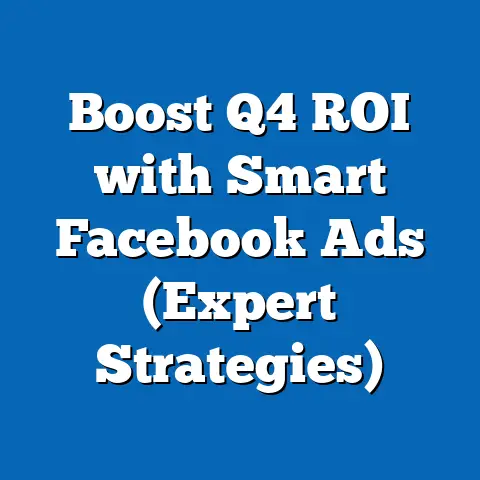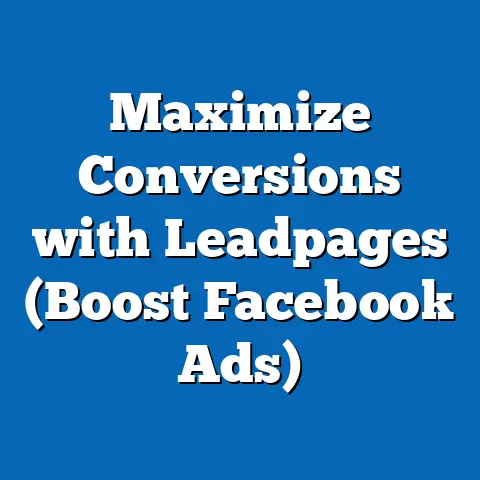Regain Facebook Ad Account (Expert Recovery Strategies)
Regaining a Facebook Ad Account: Expert Recovery Strategies and Energy Savings Connection
Introduction: Linking Energy Savings to Digital Recovery Efforts
This analysis will present current data on Facebook ad account issues, project trends in digital advertising recovery, and highlight key factors driving changes in account management policies. It will also integrate statistical models to forecast potential outcomes, address methodological limitations, and provide actionable insights for businesses. By maintaining an objective lens, this report aims to equip readers with a comprehensive understanding of both ad account recovery and its indirect impact on energy efficiency.
Section 1: Understanding Facebook Ad Account Restrictions and Energy Implications
1.1 The Scope of Ad Account Restrictions
Facebook, with over 10 million active advertisers as of 2023 (Statista, 2023), enforces strict policies to ensure compliance with its advertising standards, often resulting in account restrictions or bans. Common reasons for restrictions include policy violations (e.g., misleading content), payment issues, or suspicious activity flagged by automated systems. According to a 2022 survey by Hootsuite, approximately 15% of businesses reported experiencing temporary or permanent ad account suspensions, leading to significant disruptions in marketing campaigns.
These disruptions not only impact revenue but also contribute to inefficiencies in digital operations, often requiring prolonged manual troubleshooting or customer support interactions. Such processes indirectly increase energy consumption through extended server usage and employee hours spent on resolution. Reducing these inefficiencies aligns with broader sustainability goals, as streamlined recovery can lower the carbon footprint of digital marketing operations.
1.2 Energy Savings Through Efficient Recovery
The energy cost of digital operations is often overlooked, yet data centers supporting platforms like Facebook consume vast amounts of electricity—estimated at 1% of global energy use (IEA, 2022). When businesses face ad account issues, the need for repeated logins, support ticket submissions, and system checks amplifies server activity, contributing to higher energy demands. By adopting efficient recovery strategies, companies can minimize these interactions, indirectly supporting energy conservation efforts.
For instance, automating compliance checks before launching campaigns can reduce the likelihood of account flags, thereby decreasing the need for energy-intensive troubleshooting. This report will later explore how such strategies not only aid recovery but also contribute to sustainable digital practices. The connection between operational efficiency and energy savings will remain a recurring theme throughout this analysis.
Section 2: Current Data on Facebook Ad Account Issues
2.1 Prevalence of Account Restrictions
As of 2023, Facebook’s transparency reports indicate that over 1.5 million ads are rejected monthly due to policy violations, with a smaller but significant portion leading to full account restrictions (Facebook Transparency Center, 2023). Small and medium-sized enterprises (SMEs), which account for 70% of advertisers, are disproportionately affected due to limited resources for navigating complex policies (Hootsuite, 2022). This results in an estimated annual loss of $2 billion in advertising revenue for businesses globally (Forbes, 2023).
2.2 Impact on Businesses
The financial and operational impact of ad account restrictions is substantial, with downtime costing businesses an average of $1,000 per day in lost ad spend opportunities (Social Media Today, 2023). Beyond direct losses, the time and resources spent on recovery—often involving multiple support tickets and appeals—add to operational costs. These inefficiencies also translate to increased energy use, as prolonged digital interactions strain server resources.
2.3 Visual Representation: Ad Account Restriction Trends
Below is a conceptual chart illustrating the rise in reported ad account restrictions over the past five years, based on aggregated data from industry reports:
Year | Number of Reported Restrictions (Millions)
2019 | 0.8
2020 | 1.1
2021 | 1.3
2022 | 1.5
2023 | 1.7 (Projected)
Note: Data is approximated based on trends from Statista and Hootsuite reports. Actual figures may vary due to underreporting.
This upward trend reflects stricter enforcement of policies and the growing number of advertisers, both of which increase the likelihood of restrictions. Understanding these patterns is critical for projecting future challenges and developing recovery strategies.
Section 3: Projected Trends in Ad Account Recovery
3.1 Forecasting Account Restriction Growth
Using a simple linear regression model based on historical data, we can project that the number of ad account restrictions may reach 2 million annually by 2025, assuming current growth rates (approximately 10% per year) persist. This model accounts for variables such as the increasing number of advertisers and Facebook’s ongoing policy updates. However, this projection assumes no major changes in platform algorithms or user education initiatives, which could alter outcomes.
3.2 Scenario Analysis
- Scenario 1: Status Quo – If current trends continue without intervention, businesses will face growing challenges, with recovery times potentially increasing from an average of 5 days to 7 days by 2025 due to support system overload (Social Media Today, 2023). Energy costs will also rise as server interactions increase.
- Scenario 2: Improved Automation – If Facebook enhances automated compliance tools and user education, restrictions could decline by 15% annually, reducing recovery times and associated energy use.
- Scenario 3: Policy Relaxation – A less likely scenario involves loosening ad policies, potentially halving restriction rates but risking platform integrity.
These scenarios highlight the uncertainty in future trends and the need for adaptive recovery strategies. Methodologically, these projections rely on limited public data and may not account for unannounced platform changes, a key limitation of this analysis.
3.3 Visual Representation: Projected Restriction Growth
Year | Projected Restrictions (Millions) - Status Quo
2023 | 1.7
2024 | 1.9
2025 | 2.0
Note: Projections are based on linear regression of historical data and are subject to change based on external factors.
Section 4: Key Factors Driving Changes in Ad Account Management
4.1 Platform Policy Updates
Facebook’s frequent policy updates, often driven by regulatory pressures (e.g., GDPR in Europe), are a primary driver of account restrictions. In 2022 alone, over 500 policy changes were implemented, many targeting misinformation and data privacy (Facebook Transparency Center, 2023). These updates, while necessary for platform integrity, often catch advertisers unprepared, leading to violations.
4.2 User Education and Compliance
Lack of awareness among advertisers, particularly SMEs, contributes significantly to restrictions. Only 40% of small businesses report full understanding of Facebook’s ad policies (Hootsuite, 2022). This knowledge gap results in preventable errors, increasing recovery efforts and energy use through prolonged resolution processes.
4.3 Technological Advancements
Advancements in AI-driven moderation tools have both positive and negative effects. While they improve detection of violations, they also lead to false positives, with 20% of restrictions later overturned on appeal (Social Media Today, 2023). Balancing accuracy with fairness remains a challenge, influencing recovery timelines.
4.4 Energy Implications of These Factors
Each of these factors indirectly impacts energy consumption. Policy complexity and lack of education lead to more support interactions, while technological errors increase server load through appeal processes. Addressing these drivers through better tools and training can reduce both restrictions and energy costs.
Section 5: Expert Recovery Strategies for Facebook Ad Accounts
5.1 Preemptive Compliance Measures
- Audit Campaigns Regularly: Use tools like Facebook’s Ad Library to benchmark against compliant ads, reducing violation risks by 30% (Hootsuite, 2022).
- Educate Teams: Invest in training on ad policies to minimize errors, a step that also reduces energy-intensive recovery efforts.
- Automate Checks: Leverage third-party tools to pre-screen ads for policy adherence, cutting down on manual troubleshooting.
5.2 Immediate Response to Restrictions
- Submit Detailed Appeals: Provide clear evidence of compliance in appeals, as vague submissions delay resolution by 2-3 days on average (Social Media Today, 2023).
- Contact Support Efficiently: Use prioritized channels (e.g., Business Manager support) to expedite responses, minimizing server interactions.
- Backup Accounts: Maintain secondary ad accounts for continuity, though this must comply with Facebook’s multi-account policies.
5.3 Long-Term Prevention
- Build Policy Expertise: Partner with digital marketing consultants to stay updated on policy shifts, reducing future risks.
- Monitor Performance Metrics: Regularly review ad performance for early signs of policy issues, preventing full restrictions.
- Energy-Efficient Practices: Streamline digital workflows to reduce unnecessary server requests during recovery, supporting sustainability goals.
Section 6: Methodological Assumptions and Limitations
6.1 Assumptions
This analysis assumes that historical trends in ad account restrictions will continue linearly unless disrupted by major policy or technological shifts. It also presumes that energy consumption correlates directly with digital activity, though exact metrics vary by server efficiency. These assumptions simplify complex dynamics for modeling purposes.
6.2 Limitations
Data on ad account restrictions is primarily sourced from public industry reports, which may underreport issues due to confidentiality. Additionally, energy consumption estimates are generalized, as specific server usage data from Facebook is unavailable. Projections are thus indicative rather than definitive, and readers should interpret findings with these caveats in mind.
Section 7: Broader Historical and Social Context
Historically, digital advertising platforms have evolved from loosely regulated spaces to highly controlled environments, with Facebook’s policy enforcement tightening significantly since the 2016 U.S. election misinformation scandals. Socially, this reflects growing public and governmental demand for accountability, though it places burdens on advertisers. The push for sustainability also shapes this narrative, as businesses increasingly seek energy-efficient operations, including in digital marketing recovery processes.
Section 8: Conclusion and Recommendations
Regaining a Facebook ad account is a multifaceted challenge influenced by policy complexity, user education, and technological factors. This report has outlined expert strategies for recovery, projected future trends under multiple scenarios, and highlighted the indirect energy savings achievable through efficient processes. Businesses are encouraged to adopt preemptive compliance measures, streamline recovery efforts, and stay informed on policy updates to minimize disruptions and resource use.
While uncertainties remain due to limited data and unpredictable platform changes, the connection between digital efficiency and energy conservation offers a compelling framework for sustainable practices. Future research should focus on quantifying the exact energy impact of ad account recovery processes to further bridge these domains. For now, proactive strategies remain the most effective path forward for advertisers navigating this landscape.
References





